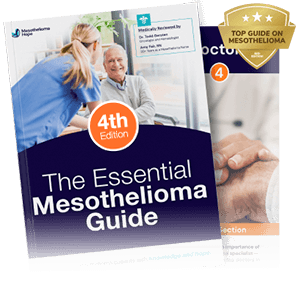What Is a Mesothelioma Biopsy?

A biopsy is when a physician collects a sample from the body for analysis. The sample may be drawn from fluid or directly from tissue depending on the specific case and affected area.
The collected sample is then sent to a pathologist (a specialist who studies body tissues and organs), who will examine it under a microscope.
The pathologist will look for specific chemical markers as well as cancer cells. If a pathologist finds possibly cancerous cells, they will run further tests to see if the patient has mesothelioma.
The only definitive way to diagnose mesothelioma is with a biopsy. However, doctors can perform additional tests, including bloodwork and imaging scans, to help confirm a diagnosis.
Learn more about mesothelioma biopsies and the next steps to take after diagnosis in our Free Mesothelioma Guide — shipped overnight to your door.
What Is Studied in a Mesothelioma Biopsy?
Pathologists typically study either fluid or tissue samples as part of a mesothelioma biopsy.
Tissue Samples
Doctors will usually try to collect tissue samples directly from a possibly cancerous tumor or growth. This is the most common way mesothelioma biopsy samples are taken.
“Often, people talk about doing a needle biopsy or taking the fluid, and sometimes the [mesothelioma] diagnosis can be established like that. Often it requires an actual tissue biopsy.”
—Dr. Joseph Friedberg, mesothelioma specialist
Most mesothelioma tissue biopsy samples usually come from the covering of the lungs (pleura) or from the abdomen lining (peritoneum) based on other symptoms and information gathered prior to the biopsy.
Fluid Samples
If the patient experiences fluid buildup as one of their symptoms, then the doctor may sometimes choose to test the fluid for mesothelioma cells.
In most cases, the fluid will either be pulled from the chest (thoracentesis), the abdomen (paracentesis), or the fluid sac surrounding the heart (pericardiocentesis).
However, even if the fluid sample is free of cancer cells, it does not mean the patient is cancer-free. It could simply mean that the sample did not contain any cancer cells. This makes tissue biopsies slightly more reliable when making a mesothelioma diagnosis.
What Type of Biopsy Is Done For Mesothelioma?
There are mainly 2 types of biopsies: non-surgical (needle) biopsies and surgical biopsies. It is important that the doctor performs the most relevant type of biopsy for the patient’s specific case in order to ensure an accurate diagnosis.
The type of biopsy used depends on the:
- Condition of the tumor/tissue
- Location of the tumor and/or where symptoms are occurring
- Patient’s overall health and well-being
As with most medical procedures, each option has its pros and cons.
Needle Biopsies
A needle biopsy is a less invasive biopsy method. It requires only local anesthetic, needs no incision, and can be done as an outpatient procedure, meaning you will not have to stay overnight in a hospital.
There are a few different types of needle biopsies.
CT-Guided Core Biopsy
This is the most commonly recommended needle biopsy. A needle with a special tip meant for cutting tissue is inserted into the lining of the abdomen or lungs.
A CT scan is used to help guide the way and a sample of tissue is removed for analysis. However, it can sometimes be hard to get a large enough sample for a definitive mesothelioma diagnosis.
Fluid Extraction Biopsy
With this type of needle biopsy, a long, hollow needle is inserted into the body to extract a sample of the fluid. As mentioned above, the cells in the fluid are analyzed to determine if they are cancerous, and if so, what type.
While being an extremely fast and relatively painless procedure, there is a risk that the sample is not sufficient enough. If this happens, the findings might be inconclusive, and another biopsy must be conducted.
We can help you find top specialists who can perform a mesothelioma biopsy and other diagnostic tests. Try our Free Doctor Match today.
Surgical Mesothelioma Biopsies
The more invasive but reliable form of biopsy is a surgical biopsy. There are two main types of surgical biopsies.
Endoscopic Biopsies
This is the most commonly used form of surgical biopsy. An endoscope (a thin tube with a small camera and light on the end) is inserted after giving the patient anesthesia and making small incisions in their body. At the end of the scope is a tool used to gather tissue samples.
There are two types of surgical endoscopic biopsies:
- Laparoscopy: Small incisions are made in the abdomen and a laparoscope is inserted to collect tissue samples. This test can help diagnose peritoneal mesothelioma.
- Thoracoscopy: If the area of concern is the lungs and chest, the procedure is called a mesothelioma thoracoscopic biopsy or thoracoscopy. Small incisions are made in the patient’s chest for a thoracoscope to fit through. The biopsy samples are removed from the lung lining to check if the patient has pleural mesothelioma.
While endoscopic biopsies are more invasive and therefore do carry more potential risks than needle biopsies, there are numerous benefits. An endoscopic biopsy allows the doctor an opportunity to see where the cancer is and if it has begun to spread.
It also allows doctors to remove both tissue and fluid (if any), which can provide physical relief for the patient as well as more samples to analyze.
Open Surgical Biopsies
Sometimes a physician deems an open surgical biopsy necessary to get an accurate diagnosis. This type of biopsy is the most invasive and has a longer recovery period.
It involves a larger incision in either the chest (thoracotomy) or abdomen (laparotomy) and allows the surgeon to remove a bigger tissue sample. It also allows for the removal of the entire tumor at times.
What to Expect During a Mesothelioma Biopsy
Knowing what to expect during a biopsy can help put you a little more at ease, even if you possibly have mesothelioma or another cancer.
What to expect will vary depending on what type of biopsy you have been prescribed.
Needle Biopsies
- A local anesthetic will be applied to the area where the needle will be inserted. You will be required to lie very still for approximately 30 minutes.
- You may have the procedure performed at your doctor’s office or in the hospital as an outpatient procedure.
- Following the biopsy, you’ll need to stay in observation for a couple of hours to ensure there are no complications. For fluid extraction, the time required is even less.
- On rare occasions, bleeding or a collapsed lung can occur, so doctors will keep you in observation until they are sure you are not dealing with either complication. After observation, you will be free to go and should feel back to normal.
Endoscopic Biopsies
- You will undergo general anesthesia and need to stay in the hospital.
- You will have one or more small incisions that will have to be tended afterward. You might feel some discomfort from them, and if so your doctor can give you pain medication.
- It is important during the days following your surgery to notify the doctor if you have any breathing difficulties or begin to feel unwell.
Open Surgical Biopsies
- Be prepared for a longer recovery time as well as more intensive after-care.
- Your doctor can notify you of how long you’ll need to stay in the hospital and what to expect after this biopsy.
We can help you learn more about what to expect during a mesothelioma biopsy and beyond. Get started right now by requesting your copy of our Free Mesothelioma Guide.
Reviewing Mesothelioma Biopsy Results
Once the pathologist receives a biopsy sample, they will examine the cells to determine what type they are.
The American Society of Clinical Oncology (ASCO) notes that most cancer biopsy results are available in 10 days or less.
The pathologist will also be able to determine what mesothelioma cell type a patient has based on the appearance of the cells as part of their work. This is very important as cell type has major effects on a patient’s overall prognosis (health outlook) and treatment options.
Getting a Second Opinion on Biopsy Results
A mesothelioma biopsy can be life-changing: Your doctor will determine if you have this cancer or not, and from there, you can start treatments that can hopefully help you live longer.
That said, it’s always a good idea to seek a second opinion on your biopsy. Through a second opinion, another doctor can review your mesothelioma biopsy findings and confirm or refute your initial diagnosis.
A second opinion is helpful because:
- You can avoid a misdiagnosis: Mesothelioma is often misdiagnosed at first. The cells of this cancer can look like those of other cancers on a biopsy test. A second opinion can determine if you were accurately diagnosed.
- You could get better news: When reviewing your biopsy results, another doctor could determine that you were misdiagnosed with a more treatable cancer. Or, they may believe you’re able to undergo more treatments than initially thought.
- You’ll get peace of mind: Even if your diagnosis doesn’t change from a second opinion, you’ll be able to rest easier knowing that your initial mesothelioma biopsy findings were accurate.
The best choice you could make for your health moving forward is to find a specialist who can help you get a biopsy and offer treatments after a diagnosis. Use our Free Mesothelioma Doctor Match to find a specialist near you today.
Mesothelioma Biopsy FAQs
What does a mesothelioma biopsy show?
A biopsy shows if there are mesothelioma cells within a sample of fluid or tissue that’s removed from a patient’s body.
If doctors see cancer cells, they can confirm the patient’s diagnosis and recommend treatments.
How is a mesothelioma biopsy done?
To perform a mesothelioma biopsy, a doctor can insert a small needle into your body using local anesthesia. They may also use minor surgery to insert an endoscope (tube with a camera at the end) and extract the sample.
A major surgery may be used in rare cases to not only retrieve a biopsy sample but also to remove cancer tumors from the body.
How long does it take to diagnose mesothelioma using a biopsy?
It takes 2-3 days to analyze the results of a general cancer biopsy, according to ASCO. However, it may take 7-10 days in complex cases.
Mesothelioma is a very rare cancer (with only about 3,000 cases diagnosed in the U.S. each year), so doctors will likely want to take more time studying a biopsy to ensure you’re properly diagnosed.
Your doctors will let you know when your mesothelioma biopsy results have been fully reviewed.
Is a biopsy the same thing as a cytology test?
Biopsies are not the same as cytology tests, though they’re similar. A biopsy is typically used by histologists, who test larger samples of fluid or tissue. Healthy cells may be seen alongside cancerous ones on biopsies.
Mesothelioma cytology tests allow doctors to extract a much smaller sample and will only look at individual cells or very small groups of them to make a diagnosis.
Your doctors can determine if a mesothelioma biopsy or cytology test will be more effective to help diagnose you.




